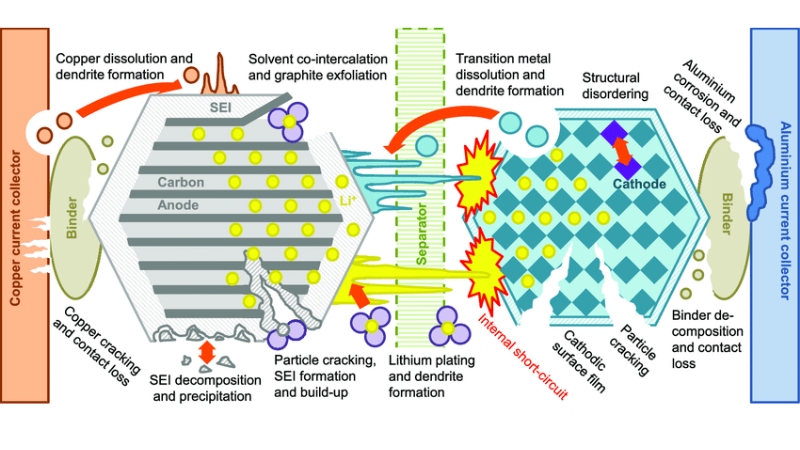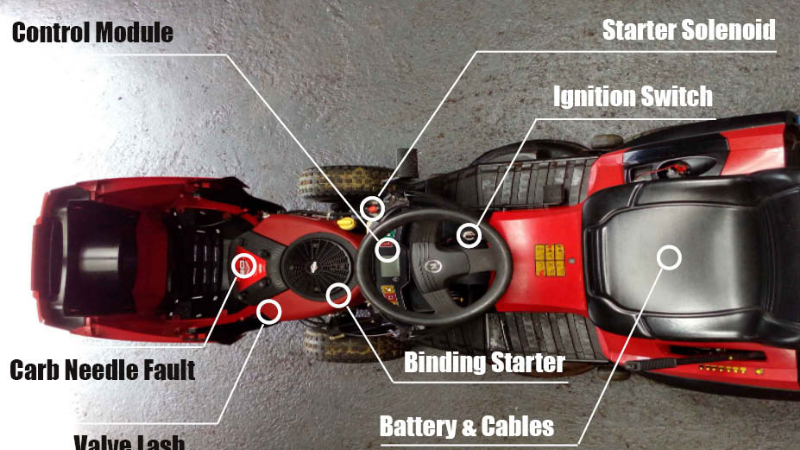Why Is My Lawnmower Clicking? Expert’s Interview
by Lee Safin
Are you noticing clicking sounds coming from your lawnmower? Though the mower clicks, you are failing to turn over the machine. What could be the reason?
Why is my lawnmower clicking?
One of the most usual causes behind a lawnmower clicking is a bad starter solenoid. In addition, a failing cranking motor, power line disturbance, internal wear and degradation in batteries, or a mechanical failure in the engine may be causing the problem.
Contents

Why Is My Lawnmower Clicking?
Before fixing the before, you want to find out why your lawnmower is clicking. Let’s figure out all possible causes one by one.
1. Internal Wear And Degradation In Batteries

The first possible cause could be a weak battery when you are wondering if this question: why is my lawnmower clicking? You should hear a sound after turning the key, meaning power is currently being delivered to the starter coil.


In order for the starter solenoid to work, it needs an excessively low current. However, for the starter motor to spin, it needs a great quantity of current.
Hence, the amount of current the battery is holding is adequate for clicking the solenoid but not cranking the motor.
Solution: A multimeter device is required to measure the amount of voltage present inside the battery.


Before measuring the DC voltage of the battery, you want to switch off the ignition system. And then raise the seat position to access the battery.
Put the multimeter probe on the positive or red battery terminal while it is set to measure DC voltage. Also, connect the black multimeter probe to the black battery terminal or negative.

The battery must have more than 12 volts of DC if it is fully charged. A minimum of 75% charge is required to make the motor cranked.
The following chart illustrates the amount of charge a battery hold depending on the voltage.
| Voltage | Charge |
|---|---|
| 11.70 | 0% |
| 11.95 | 25% |
| 12.10 | 50% |
| 12.35 | 75% |
| 12.66 | 100% |
Charging the better is necessary if it has become weak or dead. The cranking motor should get a start and work smoothly after recharging it.
2. Power Line Disturbance

If the lawnmower still is not starting, you want to check out its cable connection. Moreover, the problem could also occur even if the battery has enough charge.


In that case, you want to check out whether power cables have broken or corroded. Have you found any corrosion on the battery terminals and power lines? If yes, you need to eliminate it.
Here is the process on how to remove corrosion from cables:
- Wear protective equipment for eyes and hands.
- Now, you want to remove the cable connection from the battery. First, go for the negative one and then the positive one.
- Now, grab a wire brush and get rid of dust, grease, and rust from the battery terminals and wires’ endpoints.
- If the cleaning procedure didn’t help, sprinkle some baking soda on the battery terminals and wires’ endpoints.
- Let the baking soda becomes slightly damp, and intense bubbles will be created within a few minutes to remove the corrosion.
- After the bubbling stops, clean away any remaining corrosion with a toothbrush.
- Now, use an old piece of cloth to wipe off the solution from the battery wires and terminals.
- You can use petroleum jelly to create a thin on the battery surface to prevent corrosion.
Check out the machine whether it is starting after cleaning the corrosion. If not, measure the voltage at the red terminal post to determine whether the red battery cable provides power to the solenoid.
The voltage measurement should be more than 12 volts. Otherwise, you need to replace the red battery cable.
3. A Bad Starter Solenoid

Are you still failing to start the mower after installing a new red battery cable? If yes, a bad solenoid comes next in the list of probable suspects,
So, how will you know whether the starter solenoid is bad or not? For that, you need to measure the voltage of the black post while the solenoid is clicking.


As you start the ignition switch, few attachable meter probes are necessary to support the probes on the cables. However, you don’t need them if you have an assistant to switch on the ignition key while you are holding the probes on the wires.
Connect the red meter probe to the solenoid post after disconnecting the black starter cable. Next, join the black battery terminal to the black meter probe.
As soon as you turn on the ignition, you will hear the solenoid coil clicking. The multimeter should read more than 12 volts after power reaches the black post.
You want to change the starter solenoid if there is no voltage. If it reads more than 12 volts, the starter solenoid is supposed to work.
The next job is checking the starter solenoid cable connected from the starter to the solenoid.
Here, you will do a voltage drop test to find out the high-resistance issues rapidly. This type of test gives more reliable results, especially for huge wires with several copper strands.
You can find out the flow of current by implementing this test. By measuring the cable’s capacity, it can determine whether the starter motor can spin properly.
Apart from that, voltage is also measured from the starter motor stud to the solenoid post under this test. Generally, the voltage measurement at the starter motor stud and the solenoid post should be less than 1 volt while doing the test.
However, if the voltage in the cable exceeds one volt, it means the wire strands are damaged inside.
Here are the test steps:
- To begin the test, you want to clip the red meter probe to the cable lead and reconnect the black starter cable to the solenoid post.
- Then, raise the mower hood, and make sure there is no connection between the spark plug and the motor to prevent it from starting.
- To see everything inside clearly, you want to take out the right dash panel.
- Next, the black meter lead must be clipped to the black cable that connects the starter and the black line.
- Check the voltage after the click of the ignition key.
- You want to purchase a new starter cable if more than 1 volt is lost through them.
- If you see no problems with the starter cable, the starter motor should receive power.
So, here are the top reasons for the question of why is my lawnmower clicking? Make a list of all the reasons that need to be addressed.
What Does A Clicking Solenoid Mean?
How is your lawnmower performing these days? Are there any clicking sounds? Do you hear a single clicking sound or more while trying to start the engine?
What does a clicking solenoid mean?
A clicking solenoid means a sufficient voltage is available to drive the starter solenoid. However, it fails to maintain that voltage when it comes in contact with the starter.
In addition, a clicking solenoid has several meanings —
- Your lawnmower battery may have virtually died or become weak
- Your lawnmower battery has a loose connection or corrosion build-up
- You may be using too an old battery
- You have ensured no protection for the starter motor
They all have the potential to pop out this question: what does a clicking solenoid mean?
What Does A Bad Solenoid Sound Like On A Riding Lawn Mower?

Unless your lawnmower is not functioning properly, you can’t cut the grass efficiently. Several types of problems you may encounter on a riding lawnmower. One of them is bad solenoid sounds.
What does a bad solenoid sound like on a riding lawn mower?
The click sound made by a bad solenoid provides clues to something is wrong inside your lawnmower. The bad solenoid sound may vary based on the lawnmower model and how long you have been using the machine.
The unusual clicking sound may become worse if you delay. That’s why you want to implement a quick solution according to the problems. Hopefully, you have gotten a clear idea about this question: what does a bad solenoid sound like on a riding lawn mower?
What Are The Signs Of A Bad Solenoid?

A Bad Solenoid won’t let you run or start the machine properly. You want to address the issue after figuring it out.
What are the signs of a bad solenoid? You can learn whether your lawnmower has a bad solenoid or not by inspecting its conditions. Here are the few possible signs you will see:
- You are failing to start the engine through the battery charge is sufficient.
- The lawnmower makes clicking sounds, but you can’t crank the engine.
- Even if the engine cranks, it works very slowly, unlike before.
- Flywheel does not engage fully when starter spins (uncommon).
These are the points you should note when you want to know this query: what are the signs of a bad solenoid?
Conclusion
Are you still wondering this query: why is my lawnmower clicking? No! You are not. We have already outlined all the possible reasons for a lawnmower clicking sounds. Thanks for reading!
Last update on 2023-01-28 / Affiliate links / Images from Amazon Product Advertising API
 |
 |
 |
 |

About Lee Safin
Lee Safin was born near Sacramento, California on a prune growing farm. His parents were immigrants from Russia who had fled the Bolshevik Revolution. They were determined to give their children a better life than they had known. Education was the key for Lee and his siblings, so they could make their own way in the world. Lee attended five universities, where he studied plant sciences and soil technologies. He also has many years of experience in the U.S. Department of Agriculture as a commercial fertilizer formulator.
Thoughts on "Why Is My Lawnmower Clicking? Expert’s Interview"
 |
 |
 |
 |
Get FREE Gardening Gifts now. Or latest free toolsets from our best collections.
Disable Ad block to get all the secrets. Once done, hit any button below
 |
 |
 |
 |